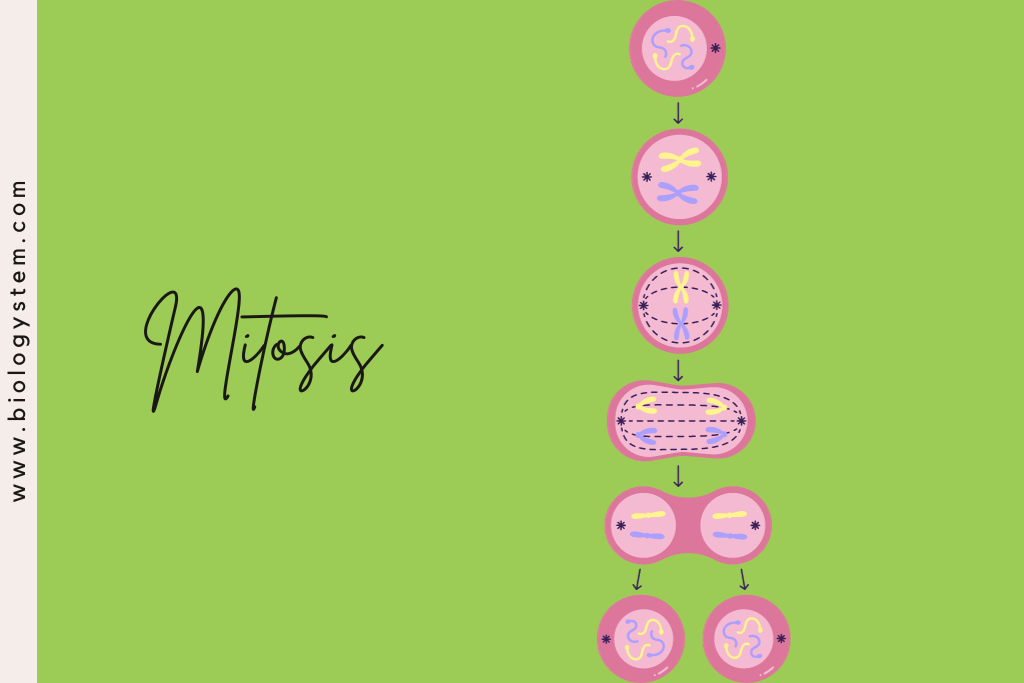Introduction:
Welcome to this engaging lesson on “Understanding Mitosis and the Cell Cycle.” In this lesson, we will delve into the fascinating world of cell division, exploring how our bodies grow, repair, and maintain themselves. Just like a copy machine creates duplicates of important documents, our cells engage in a remarkable process called mitosis to create identical copies of themselves.
Why is this understanding crucial? Because it underlies the very essence of life, governing how organisms grow, repairs damaged tissues and ensures the proper functioning of their bodies. So, let’s embark on this scientific adventure to unravel the secrets of mitosis and the cell cycle.
Part 1: Cell Division
Cell division is the process by which a single parent cell divides into two or more daughter cells, each containing a nearly identical set of genetic material. This fundamental biological process is essential for the growth, development, and maintenance of living organisms.

Significance of Cell Division
Cell division plays a pivotal role in several key aspects of biology and the life of an organism:
- Growth: Cell division is the primary mechanism behind the increase in the number of cells in an organism. During development, a fertilized egg undergoes numerous rounds of cell division, resulting in a multicellular organism.
- Tissue Repair: When an organism is injured, cell division is crucial for repairing damaged tissues. Cells at the injury site rapidly divide and replace the damaged or dead cells.
- Development: In multicellular organisms, cell division is fundamental to the development of various body structures and organs. It determines the size, shape, and organization of these structures.
- Replacement: In many tissues and organs, cells have a limited lifespan. Cell division ensures that old or dying cells are continually replaced with new ones, maintaining the proper function of the tissue or organ.
- Asexual Reproduction: In some organisms, cell division is the primary method of reproduction. For example, in single-celled organisms like bacteria and amoebas, cell division results in the formation of two genetically identical daughter cells.
- Genetic Diversity: While cell division typically produces genetically identical daughter cells, it can also play a role in generating genetic diversity. This occurs during meiosis, a specialized form of cell division that leads to the formation of sex cells (sperm and egg cells) with half the usual number of chromosomes. When these cells unite during fertilization, they contribute to the genetic diversity of the offspring.
Part 2: The Cell Cycle

1. G1 Phase (Gap 1):
Definition: The G1 phase is the first gap phase of the cell cycle, which occurs after a cell has divided (e.g., during cytokinesis) and before it begins DNA replication.
Significance:
- Cell Growth: During the G1 phase, the cell grows in size, accumulating the necessary energy and nutrients to support DNA replication in the next phase.
- Monitoring and Checkpoints: The cell monitors its internal environment to ensure that it’s in a suitable condition for DNA synthesis. If there are any issues or damage, the cell can trigger repair mechanisms or enter a state of dormancy (G0 phase) if necessary.
- Cell Function: In multicellular organisms, G1 also plays a role in cell specialization, determining the cell’s future function.
2. S Phase (Synthesis):
Definition: The S phase is the synthesis phase of the cell cycle. During this phase, DNA replication occurs, resulting in the duplication of the cell’s genetic material.
Significance:
- DNA Replication: The primary purpose of the S phase is to replicate the cell’s DNA. Each chromosome is duplicated, forming two sister chromatids held together at the centromere.
- Genetic Fidelity: Accurate DNA replication is vital to maintaining genetic fidelity. Errors in DNA replication can lead to mutations or genetic disorders.
- Preparation for Division: By the end of the S phase, the cell has a complete set of duplicated chromosomes, ready for distribution to daughter cells during mitosis.
3. G2 Phase (Gap 2):
Definition: The G2 phase is the second gap phase of the cell cycle, occurring after DNA replication in the S phase.
Significance:
- Final Preparations: During G2, the cell undergoes final preparations for cell division. This includes the synthesis of proteins and organelles needed for cell division.
- Quality Control: G2 serves as a checkpoint to ensure that DNA replication is error-free. If there are issues, the cell can activate repair mechanisms.
- Cell Growth: Additional cell growth occurs in G2, making sure the cell is of adequate size before division.
4. M Phase (Mitosis):
Definition: The M phase, or Mitosis, is the final phase of the cell cycle. It’s the phase during which the cell actively divides into two daughter cells.
Significance:
- Exact Chromosome Segregation: Mitosis is responsible for the precise separation of the duplicated chromosomes. This ensures that each daughter cell gets an identical set of genetic material.
- Cell Division: The main goal of the M phase is to divide a single parent cell into two identical daughter cells. This is crucial for growth, tissue repair, and replacement of old or damaged cells in multicellular organisms.
- Ensuring Genetic Stability: By accurately distributing genetic material, mitosis contributes to maintaining genetic stability and preventing errors in the transmission of genetic information to the next generation of cells.
Prophase:

Key Events during Prophase:
- Chromatin Condensation: During prophase, one of the most notable events is the condensation of chromatin into visible, compact structures called chromosomes. This condensation is essential because it helps prevent the long, fragile strands of DNA from becoming entangled during cell division.
- Nuclear Envelope Breakdown: The nuclear envelope, which separates the cell’s nucleus from the rest of the cell, begins to break down. This is necessary to allow the spindle fibers access to the chromosomes.
- Spindle Fiber Formation: Another crucial event during prophase is the formation of spindle fibers, also known as microtubules. These spindle fibers radiate from centrosomes located at opposite ends (poles) of the cell. They will play a vital role in moving and segregating the chromosomes during the later stages of mitosis.
Metaphase:

Chromosome Alignment along the Metaphase Plate:
- During metaphase, the spindle fibers have fully formed and attach to the centromeres of the condensed chromosomes. This results in the precise alignment of the chromosomes along the metaphase plate, which is an imaginary plane equidistant between the two poles of the cell.
Significance of Alignment:
- The alignment of chromosomes along the metaphase plate is of paramount importance. It ensures that when the sister chromatids separate during anaphase, they are distributed to the two daughter cells in an orderly and balanced manner. This alignment is critical in guaranteeing that each daughter cell receives an identical set of chromosomes, thereby maintaining the genetic integrity of the new cells.
Anaphase:

Dynamic Separation of Sister Chromatids:
- Anaphase is a highly dynamic phase. The sister chromatids, which were held together at the centromere, are suddenly pulled apart by the contracting spindle fibers. This separation leads to the movement of each chromatid to opposite poles of the cell.
Importance of Identical Chromosome Distribution:
- The significance of this dynamic separation lies in ensuring that the genetic material is accurately distributed to the two daughter cells. If this process were not tightly controlled, it could result in an unequal distribution of chromosomes, potentially leading to genetic abnormalities in the resulting daughter cells. Anaphase is responsible for maintaining the genetic stability of the new cells.
Telophase:

Events in Telophase:
- Telophase is a phase of transition, where several events occur:
- The separated sister chromatids begin to de-condense, reverting to their less compact chromatin form.
- The nuclear envelope, which had previously broken down during prophase, reforms around each set of de-condensing chromosomes.
- Additionally, the cell starts preparing for cytokinesis, the final stage of cell division.
Preparation for Cytokinesis:
- While not technically part of mitosis, telophase prepares the cell for the process of cytokinesis, where the cell will physically divide into two separate daughter cells. This preparation includes the formation of the cleavage furrow in animal cells or the cell plate in plant cells.
Cytokinesis:
Definition and Role in Cell Division:
- Cytokinesis is the final step in cell division, occurring after the completion of mitosis. It is the process by which the cell physically divides into two daughter cells. In animal cells, a cleavage furrow forms as the cell membrane pinches inwards, ultimately creating two separate cells. In plant cells, a structure known as the cell plate develops and eventually becomes a new cell wall.
Differences Between Animal and Plant Cell Cytokinesis:

- The primary difference lies in the method of division:
- Animal cells use a cleavage furrow to pinch the cell membrane inwards.
- Plant cells, which have rigid cell walls, form a cell plate. This structure eventually becomes the new cell wall, creating two separate plant cells.
Part 5: Significance of Mitosis
Elaboration on Regulated Cell Division: Regulated cell division is a critical aspect of maintaining a healthy, functioning organism. The precise control of when, where, and how cells divide is essential for various reasons:
- It ensures that an organism’s growth is well-coordinated. As an organism develops, different tissues and organs need to grow at specific rates and times.
- Regulated cell division is crucial for tissue repair. When you cut your skin or damage other tissues, cell division quickly replaces the lost or damaged cells.
- It helps maintain genetic stability by ensuring that new cells receive an identical set of chromosomes, preventing errors and mutations.
Consequences of Errors in Mitosis, Such as Cancer: Errors in mitosis can lead to serious consequences, and one of the most well-known is cancer. When the regulation of the cell cycle breaks down, cells may:
- Divide uncontrollably, forming masses of cells called tumors.
- Invade nearby tissues and organs.
- Spread to other parts of the body, a process known as metastasis. Cancer can be life-threatening, highlighting the paramount importance of proper mitotic regulation. Understanding the significance of mitosis underscores the need for further research and advancements in cancer prevention and treatment.
Conclusion
In conclusion, the journey through mitosis and the cell cycle has revealed a fascinating world of orchestrated cell division. From the G1 phase, where cells prepare for division, through the precise alignment of chromosomes in Metaphase, the dynamic separation of sister chromatids in Anaphase, and the transition and preparation for cytokinesis in Telophase, we’ve explored the intricate mechanisms that ensure the genetic stability and functionality of an organism’s cells.
Mitosis is significant in maintaining a healthy, functioning organism. Regulated cell division is essential for growth, development, tissue repair, and genetic stability. Errors in mitosis, such as those leading to cancer, serve as a stark reminder of the importance of understanding and controlling these processes.
Additional Resources
For those eager to delve deeper into the subject, here are some additional resources to consider:
These resources will provide in-depth knowledge on cell division, mitosis, and related topics.
Assessment
To assess your understanding of mitosis and the cell cycle, consider the following quiz questions:
- What is the primary purpose of the G1 phase in the cell cycle?
a) DNA replication
b) Growth and preparation
c) Formation of spindle fibers
d) Sister chromatid separation
- Why is the alignment of chromosomes in metaphase critical for the cell division process?
a) It ensures that the chromosomes can de-condense.
b) It ensures that the sister chromatids remain connected.
c) It guarantees that each daughter cell gets an identical set of chromosomes.
d) It has no significant purpose in cell division.
- What is the role of cytokinesis in cell division?
a) It ensures the precise alignment of chromosomes.
b) It distributes the genetic material to daughter cells.
c) It physically divides the cell into two separate daughter cells.
d) It prepares the cell for DNA replication.
Feel free to answer these questions to test your knowledge of mitosis and the cell cycle.
Thank you for exploring this lesson, and remember to stay curious and keep learning.

